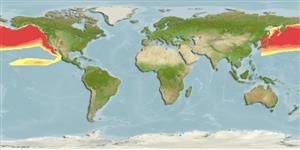>
Gadiformes (Cods) >
Moridae (Morid cods)
Etymology: microlepis: From the Greek 'micro' meaning small and 'lepis' meaning scale (Ref. 6885).
More on author: Bean.
Environment: milieu / climate zone / depth range / distribution range
экология
морской батипелагический; пределы глубины 175 - 3048 m (Ref. 6793). Deep-water; 64°N - 12°N, 133°E - 106°W (Ref. 1371)
North Pacific: Shikoku Island, Japan to Navarin Canyon in the Bering Sea, the Gulf of California and Johnston Island.
Size / Вес / Возраст
Maturity: Lm ? range ? - ? cm
Max length : 75.0 cm TL самец/пол неопределен; (Ref. 2850); наибольший вес (опубликованные данные): 2.1 kg (Ref. 56581); наибольший возраст (опубликованны данные): 20 годы (Ref. 56581)
колючие лучи спинного плавника (общее число): 0; членистые (мягкие) лучи спинного плавника (общее число): 54-60; колючие лучи анального плавника 0; членистые (мягкие) лучи анального плавника: 39 - 42. Head short; snout pointed; chin barbel short. Color variable from pale but definite blue gray or olive green throughout to deep violet or blue black; darker on outer edges of fins and very dark on edge of caudal and fins on ventral part of body; dark on lower part of gill cover and branchiostegals (Ref. 6885).
Inhabits the lower regions of the continental slope between 800 m and 1, 800 m. It appears that sex segregation is also basic to this species, but whether or not the species migrates extensively or uses the North American west coast slopes only as feeding areas is not known (Ref. 1371). Benthopelagic (Ref. 58302). Feeds on benthic invertebrates (Ref. 9319). Taken frequently by deep slope water trawlers fishing for Microstomus pacificus and deepwater Sebastes species (Ref. 1371).
Life cycle and mating behavior
половая зрелость | размножение | нерест | икра | Fecundity | личинки
Cohen, D.M., T. Inada, T. Iwamoto and N. Scialabba, 1990. FAO species catalogue. Vol. 10. Gadiform fishes of the world (Order Gadiformes). An annotated and illustrated catalogue of cods, hakes, grenadiers and other gadiform fishes known to date. FAO Fish. Synop. 125(10). Rome: FAO. 442 p. (Ref. 1371)
Статус Красного Списка МСОП (Ref. 130435)
Угроза для людей
Harmless
Использование человеком
рыболовство: рыболовство как средство для существования
дополнительная информация
народные названиясинонимыобмен веществхищникиэкотоксикологияразмножениеполовая зрелостьнерестSpawning aggregationFecundityикраРазвитие икры
ссылкиаквакультура (рыбоводство)особенности рыбоводствастепень растяжениягенетикаElectrophoresesнаследуемостьболезниобработкаNutrientsMass conversion
инструменты
Специальные отчеты
Скачать в формате XML
ресурсы в Интернет
Estimates based on models
Preferred temperature (Ref.
123201): 0.2 - 3.9, mean 2.4 °C (based on 377 cells).
Phylogenetic diversity index (Ref.
82804): PD
50 = 0.7500 [Uniqueness, from 0.5 = low to 2.0 = high].
Bayesian length-weight: a=0.01259 (0.00669 - 0.02368), b=3.24 (3.07 - 3.41), in cm total length, based on LWR estimates for this species & (Sub)family-body (Ref.
93245).
Trophic level (Ref.
69278): 3.5 ±0.37 se; based on food items.
Generation time: 12.2 ( na - na) years. Estimated as median ln(3)/K based on 1
growth studies.
устойчивость к внешним воздействиям (Ref.
120179): низкий, минимальное время удвоения популяции 4.5-14 лет (Assuming tmax>10).
Fishing Vulnerability (Ref.
59153): High to very high vulnerability (68 of 100).
